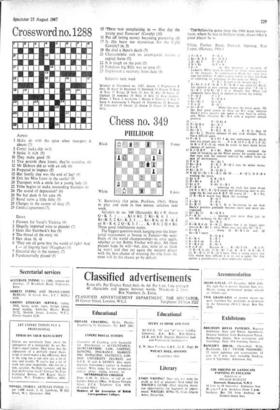Chess no. 349
• PHILIDOR
V. Bartolovic (1st prize, Problem, 1961). White to play and mate in two moves; solution next week.
Solution to no. 348 (Hancock): Kt x P. threat Q-K 5. 1 . . . Kt x Kt; 2 Kt-K 6. 1 . . . Kt-K 5; 2 Kt-K 2. 1 ... Kt- B 6; or R-K 6 or R - R 4; 2 Q -K 3. 1 . K - B 6; 2 Q X Kt. Three good interference mates.
The biggest question-mark hanging over the Inter- zonal tournament at Sousse in Tunisia-the semi- finals of the world championship-is, once again, whether or not Bobby Fischer will play. All chess players hope he will-but, alas, most of us think he won't and that yet again the western player with the best chance of wresting the title from the USSR Will let his chance go by default.
-111k*fellOwing game from the 1966 team tourna- ment, where he was in brilliant form, shows what'a great player he is.
White, Fischer. Black, Portisch. Opening. Ruy Lopez. (Havana. 1966.) 1 P - K 4 P - K 4 2 Kt - K B 3 Kt - Q B 3 3 13.- Ifx 5 P - Q R 3 '4'8' x Kt QPx B
5 0 -0 . In this variation, a favourite of 1-esker's. White plays to exploit his better pawn position In the endgame. In coniNtisation Black has open lines . and two bishops It lakes a area& mrster to have any hope of exploiting an advantage 01 this kind or White. P - B 3. It used to be 'bought that 5 . . B- kt 5: 6 P - K R 3. P - K R 4 was good for Black, but opinion is now veering round and alter 7 P - Q 3,
Q - B 3: 8 Q Kt - Q 2 it is thought that White can ultimately force Black to capture or retreat the bishop. 6 P - Q 4 P x P 7 Kt XP P-Q 84 8 Kt - Kt 3 Q x Q 9RxQ 8-03
10 Kt - R 51 . . White has now the better game. He
Bit four good pawns to three on K's wing, whereas Black's extra queen's side pawn o very hard to utilise: also White threatens Kt - 8 4 with a superior overall position.
10 - . . P - Q Kt 4 PI P-Q B 4 Kt - K 2 12 /3 -IC 3 P - B 4
13 Kt - B 3 P- B 5. If 13 . . B - Q 2: then 14 At -Kt 7. Despite absence of any clear mistake. Black has • difficult game.
14 P- K 5 B x P? I do not understand why Black does not simply play 14 . . . P X B; 15 P x 13, P X P cls; 16 K X P 0-0 ch, when he seems to have much better chances of survival.
15 13 xQBP Bx Kt. Black perhaps overrated the value of breaking up the White pawns: his trouble now is that even with the reduced material he suffers from his . lack of development.
16 P X B Kt - Kt 3 17 Kt - B 6 B- K 3. B-Q 2 may be rather better.
18 P X P P x P 19 Kt - R 71 R - Q Kt 1 20R(Q 1)-Kt 1 K-B 2.0r 20 B-Q 2; 21 P-B4 winning the pawn.
21 Kt x P K R - Q 1 22 R - Kt 4 BXP 23 Kt X P R (Kt 11- B I 24 P - R 4! . . . removing the back line mate threat (24 R X 877, K - Q 8 mate) and threatening later to dis- lodae the Kt and win K B P. Of oourse 24 . . R x Kt; 25 B- Kt 6 would lose Black the exchange.
24 . . . R - Q 7 25 B -Kt 6 P - ID 6 26 B -K 3! R -K 7. It is fascinating to see how Black's position gradually becomes more and more dia. organised.
27 Kt -Kt 51 R - Q R 1
28 P.- R 51 . .. wanting even more than just to
win the exchange by Kt -0 4.
28 . . . Kt - K 4 29 R -K B 4 ch K - K 2? Better-but it no longer mat- ters-is K - Kt 1, when White may just play Kt -0 4.
30 R - Q I . . . threat 31 B - B 5 ch and 32 Kt -B 7 mate.
30 . . . R - Q B 1 31 R - K 4 K - B 3 32 R-Q6ch K-84 R - B 4 ch K - Kt 4 .4RxP ch Resigns 34 ... K - Kt 5 (34 . . K X P;
35 R-B 5 ch): 35 R - Kt 3 ch K - 4: 36 R - Kt 3 ch. K - K 5; 37 R - Q 4 mate. Only a strong player can fully realise how difficult it is to win a game like this against a grandmaster; a most impressive victory.






























 Previous page
Previous page